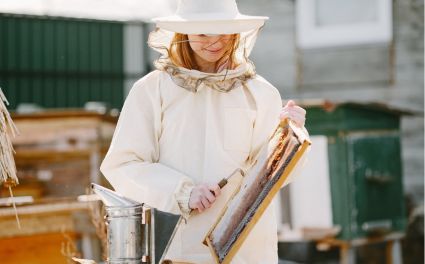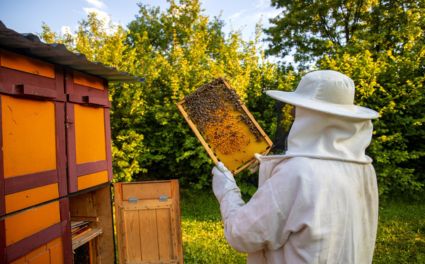Beekeeping is one of the most fascinating and rewarding hobbies — but it also requires the right protective gear to ensure safety. Whether you’re a beginner tending your first hive or a seasoned apiarist managing dozens, protective clothing plays a crucial role in keeping you safe from bee stings and potential allergic reactions.
Among all protective gear, the beekeeper suit stands out as the most essential piece. It creates a secure barrier between the beekeeper and the hive, allowing for calm, confident, and sting-free hive inspections.
This comprehensive guide explores how beekeeping suits work, what they’re made of, and how modern designs — such as those offered by trusted brands like OZ Armour — make beekeeping safer and more comfortable than ever.
🐝 Purpose of Beekeeping Suits
The purpose of beekeeping suits is simple yet vital — to create a shield that separates the beekeeper from their bees while ensuring breathability and comfort during long hours of work.
Protection from Bee Stings
Bees are naturally defensive and can react quickly to movement, scent, or vibrations around their hive. A well-made beekeeping suit acts as an effective protective barrier, preventing stingers from reaching the skin. The suit’s multi-layered design reduces the chance of painful stings and provides peace of mind to the beekeeper.
For complete protection, beekeepers often combine their suits with other essential protective wear such as:
Each of these items contributes to creating a full-body protective layer that covers every vulnerable area.

🧵 Construction of a Beekeeping Suit
Modern beekeeping suits are carefully engineered to combine protection, comfort, and practicality. They’re made up of multiple layers and components designed to keep beekeepers cool and safe while working.
Outer Layer
The outer layer is typically made from durable materials like cotton, polyester, or a combination of both. These fabrics are selected for their strength and resistance to bee stings. Many premium suits feature double stitching and reinforced seams, preventing bees from finding entry points.
Some advanced suits use a three-layer ventilated mesh structure — a design where each layer creates spacing that keeps the bee’s stinger from reaching the skin while allowing airflow for maximum comfort.
Inner Layer
Inside the suit, a breathable mesh lining is often used. This layer helps with ventilation, keeping air circulating to prevent overheating. It’s also lightweight, ensuring that the beekeeper can move freely without feeling weighed down.
The inner lining is usually made of nylon or polyester, providing resistance to tearing and durability against sharp edges around hive boxes.
Additional Components
Apart from the body of the suit, accessories like veils, gloves, and boots play a critical role.
-
Veils protect the face and neck while allowing visibility through fine mesh netting.
-
Gloves are designed from soft leather or synthetic materials to protect the hands without sacrificing dexterity.
-
Some suits also include ankle guards or elastic cuffs to ensure bees cannot crawl inside.
For young enthusiasts, specially designed Beekeeping Kids Suits ensure that safety and comfort are never compromised, even for junior beekeepers learning the craft.
⚙️ How Beekeeping Suits Work
The effectiveness of a beekeeping suit lies in its functional design, which combines physical protection with ventilation and coverage.
1. Physical Barrier
The suit acts as a physical barrier between the beekeeper and the bees. Its sting-resistant fabric creates a buffer that prevents bee stingers from penetrating. The thickness of the layers ensures that the stinger can’t reach the skin, even when bees attempt to sting through the fabric.
2. Preventing Direct Contact
The design ensures no direct contact between the fabric and the beekeeper’s skin. This is achieved by using spaced-mesh layering — the air gap makes it impossible for a bee’s stinger to bridge the distance.
Additionally, cuffs, zippers, and Velcro closures around the wrists, ankles, and neck ensure there are no open gaps for bees to enter.
3. Complete Coverage
From head to toe, the suit covers all areas where bees might sting. A veil shields the face and neck, gloves protect the hands, and ankle guards seal the legs.
This complete coverage lets beekeepers handle frames, inspect brood boxes, and harvest honey with confidence, knowing they’re fully protected.
🌬️ Ventilation and Comfort Features
Earlier beekeeping suits were thick and heavy, often making the wearer feel hot and uncomfortable. However, innovations from brands like OZ Armour have transformed modern suits into breathable, lightweight, and flexible gear.
Advanced Ventilated Mesh
Ventilation is one of the key comfort features in today’s beekeeping suits. A triple-layer mesh allows air to flow freely through the fabric, reducing body heat even in warm weather. This feature is especially appreciated by beekeepers in hotter regions.
Soft and Durable Materials
High-quality cotton-polyester blends provide the best of both worlds — cotton adds softness and breathability, while polyester adds strength and resistance to shrinkage. This combination ensures long-lasting protection without compromising comfort.
Freedom of Movement
Beekeeping requires bending, lifting frames, and moving around the hive. Suits are therefore designed with ample room for movement, elastic waistbands, and adjustable closures. Some even include knee and elbow reinforcements for added flexibility and durability.
🧒 Beekeeping Suits for Kids
Beekeeping has become a family-friendly activity, and many young enthusiasts love to assist with hive inspections. For them, beekeeping kids suits are specifically made to provide protection while ensuring lightweight comfort. These suits are smaller in size but maintain the same quality standards as adult suits, featuring breathable fabric and secure closures for full safety.
🦶 Ankle and Lower Body Protection
One commonly overlooked area is the ankle. Bees can sometimes crawl upward through trouser cuffs or openings in the footwear area. That’s why beekeeping trousers and ankle protection gear are important additions to a beekeeper’s outfit.
Elastic cuffs, secure zippers, and overlapping fabric layers ensure bees cannot find their way inside the suit. Combined with good beekeeping boots, they complete the defensive ensemble.
🧥 Complementary Protective Gear
A complete beekeeping outfit includes several protective layers that work together. Apart from full suits, many beekeepers prefer:
-
Beekeeping Jackets for quick inspections or lighter tasks.
-
Beekeeping Gloves for hand protection.
-
Beekeeping Veils for facial safety.
This modular approach allows beekeepers to adapt their gear to weather conditions and task requirements.

🌿 Where to Find Reliable Beekeeping Gear
When looking for dependable, high-quality beekeeping suits and accessories, many beekeepers turn to OZ Armour, a trusted name known for innovation and comfort. Their gear is designed to provide exceptional protection with breathable materials, secure fittings, and ergonomic designs that enhance the beekeeping experience.
From ventilated suits to durable gloves and kid-friendly designs, OZ Armour products help ensure that every beekeeper can work with confidence and safety.
Explore the full range of beekeeping gear — including suits, jackets, gloves, veils, and more — at OZ Armour and discover equipment tailored to every type of beekeeper.
🧭 Final Thoughts
Beekeeping is an art that requires skill, patience, and proper safety measures. A well-designed beekeeping suit not only shields from stings but also builds confidence, allowing beekeepers to interact more calmly with their colonies. With thoughtful construction, breathable materials, and complete coverage, today’s suits make beekeeping safer and more enjoyable.
For those who wish to deepen their understanding of hive management, safety, and gear selection, visit the \OZ Armour to read more blogs about beekeeping, expert tips, and product guides.



